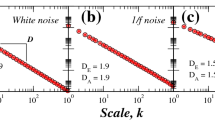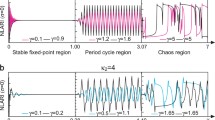Abstract
The number of babies born to teenagers ranging in ages from 10 to 19 in the state of Texas during the years 1964 to 1990 is not strictly regular, but has both a systematic and random component. Herein we use the relative dispersion, the ratio of the standard deviation to the mean of a time series, to show by systematically aggregating the teen-birth data, that the correlation in the number of teen births is a modulated inverse power law. This scaling of the aggregated relative dispersion indicates the existence of long-time memory in the underlying control process and that the social process leading to teen pregnancy and having a baby are random, fractal and nonlinear. It is shown that this statistical behavior is the same as that observed in other sexual partner selection processes. We discuss the possible allometric nature of time series having such an inverse power-law character, and the implications of such memory for the properties of social control systems.
Similar content being viewed by others
REFERENCES
Anderson, R. M., & May, R. M. (1988). Epidemiological parameters of HIV transmission, Nature 333, 514-517.
Bassingthwaighte, J. B., Liebovitch, L. S., & West, B. J. (1994). Fractal Physiology. Oxford: Oxford University Press.
Blythe, S. P., & Castill-Chavez, C.(1995). Scaling of sexual activity. Nature 344, 202.
Cesario, S. (1998). Influence of the economy on teen and adult birth patterns in Oklahoma 1980-1995: A time series analysis. Texas Woman' University, unpublished manuscript.
Dooley, K., Hamilton, P., Cherri, M., West, B. J., & Fisher, P. (1997). Chaotic behavior in society: Adolescent childbearing in Texas, 1964-1990. In R. A. Eve, S. Horsfal, and M. E. Lee (Eds.), Chaos, complexity, and sociology (pp. 243-268). Thousand Oaks: Sage.
Feder, J. (1988). Fractals, New York: Plenum Press.
Hamilton, P., West, B. J., Mackey, H., Cherri, M., & Fisher, P. (1994a). Evidence of nonlinear dynamics in teen births in Texas 1964-1990. in P. L. Chinn (Ed.), Advanced Methods of Inquiry (pp.160-176), Gaithersberg, MD: Aspen.
Hamilton, P., West, B. J., Mackey, H., Cherri, M., & Fisher, P. (1994b). Preliminary evidence of nonlinear dynamics in births to adolescents in Texas 1964-1990. Theoretical and Applied Chaos in Nursing, 1(1), 15-22.
Huxley, J. S. (1932). Problems of relative growth. New York: Dial Press.
Lee, M. E. (1997). From enlightenment to chaos: toward non modern social theory. In R. A. Eve, S. Horsfal, and M. E. Lee (Eds.), Chaos, complexity, and sociology (pp. 15-29). Thousand Oaks: Sage.
Lowen, S. B., & Teich, M. C. (1995). Estimation and simulation of fractal stochastic point processes. Fractals, 3, 183-210.
Mandelbrot, B. B. (1977). Fractals, form, chance and dimension, San Francisco: W.H. Freeman and Co.
Mandelbrot, B. B. (1983). The fractal geometry of nature. San Francisco: W.H. Freeman and Co.
Montroll, E. M., & West, B. J. (1987). An enriched collection of stochastic processes. In E. W. Montroll and J. Lebowitz (Eds.). Fluctuation Phenomena. 2nd Edition (pp. 61-173). Amsterdam: North-Holland.
Pareto, V. (1897). Cours d'economie politique, Lausanne; (1916). Tiattato di Socilolgia Generale, 2 Vol, Firenize, Barbera.
Stanley, H. E., Buldyrev, S. V., Goldberger, A. L., Goldberger, Z. D., Havlin, S., Mantegna, R. N., Ossadnik, S. M., Peng, C.-K., & Simons, M. (1994). Statistical mechanics in biology: How ubiquitous are long-range correlations? Physica A, 205, 214-253.
Taylor, L. R. (1961). Aggregation, variance and the mean. Nature, 189, 732-734.
Taylor, L. R., & Taylor, R. A. (1977). Aggregation, migration and population mechanics. Nature, 265, 415-417.
Taylor, L. R., & Woiwod, I. P. (1980). Temporal stability as a density-dependent species characteristic. Journal Animal Ecology, 49, 209-218.
Theiler, J., Eubank, S., Longtin, A., Galdrikian, B., & Farmer, J. E. (1992). Testing for nonlinearity in time series: the method of surrogate data. Physica D, 75, 190-208.
van Beek, J. H. G. M., Roger, S. A., & Bassingthwaighte, J. R. (1989). Regional myocardial flow heterogeneity explanined with fractal networks. American Journal of Physiology, 257, (Heat Circulation Physiology 26): H1670-H1680.
Wang, M. C., & Uhlenbeck, G. E. (1945). Theory of Brownian motion. Reviews of Modern Physics, 17, 323-348.
West, B. J. (1999). Physiology, promiscuity, and prophecy at the millennium: A tale of tails. River Edge, New Jersey: World Scientific.
West, B. J., & Deering, W. (1995). The lure of modern science: Fractal thinking. River Edge, New Jersey: World Scientific.
West, B. J., & Griffin, L. (1998). Allometric control, human gait and inverse power laws, Fractals, 6, 101-108.
West, B. J., & Grigolini, P. (in press). Fractional differences, derivatives and fractal time series. In R. Hilfer (Ed.), Applications to fractional calculus in physics. Singapore: World Scientific.
West, B. J., Novars, M. N., & Kavcic, V. (1996). Fractal probability density and EEG/ERP time series. In P.M. Iannoccone & M. Khokha (Eds.) Fractal geometry in biological systems (pp. 267-314). New York: CRC Press.
Wilson, K. (1993). The renormalization group and critical phenomena. In G. Ekspong (Ed.), Nobel Lectures Physics 1981-1990 (pp. 102-134). River Edge, New Jersey: World Scientific.
Zaslavsky, G. M., Edelman, M., & Niyazov, B. A. (1997). Self-similarity, renormalization, and phase space nonuniformity of Hamiltonian chaotic dynamics. Chaos, 7, 159-171.
Zipf, G. K. (1949). Human behavior and the principle of least effort: An introduction to human ecology. Cambridge MA: Addison-Wesley.
Author information
Authors and Affiliations
Rights and permissions
About this article
Cite this article
West, B.J., Hamilton, P. & West, D.J. Random Fractal Time Series and the Teen-Birth Phenomenon. Nonlinear Dynamics Psychol Life Sci 4, 87–111 (2000). https://doi.org/10.1023/A:1009520029511
Issue Date:
DOI: https://doi.org/10.1023/A:1009520029511




